Manufacturing Leaders Get a Sneak Peek at Creators Wanted
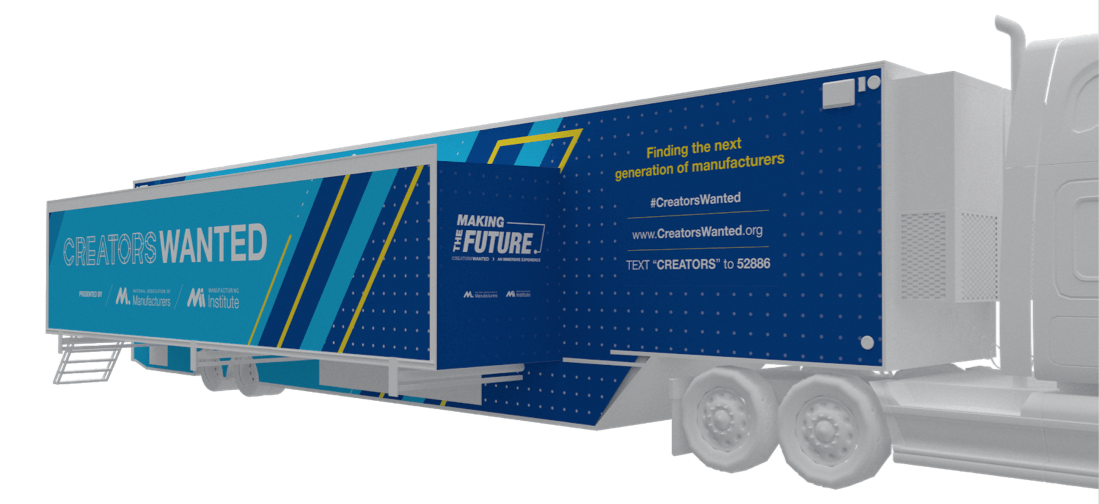
The NAM and The Manufacturing Institute unveiled their Creators Wanted experience last week in Dallas, previewing it for the NAM’s Executive Committee as well as local business leaders, workforce development officials and the media. Visitors got an exclusive look at this “mobile manufacturing experience” that will soon embark on a tour around the country, showing Americans what modern manufacturing is all about.
As NAM President and CEO Jay Timmons said, “Creators Wanted will help a new generation of emerging and displaced workers see themselves in a modern manufacturing career, while also adding to the industry’s talent pipeline by engaging veterans, women and communities of color, all critical to expanding the workforce of tomorrow.”
What they saw: Below, ExxonMobil Senior Vice President Neil Chapman, Celanese Corporation Chairman, CEO and President Lori Ryerkerk, Toyota Executive Vice President of Product Support and Chief Quality Officer Chris Nielsen and Trane Technologies Chairman and CEO (and NAM Board chair and co-chair of the Creators Wanted campaign) Mike Lamach get a first look at this interactive, hands-on experience.
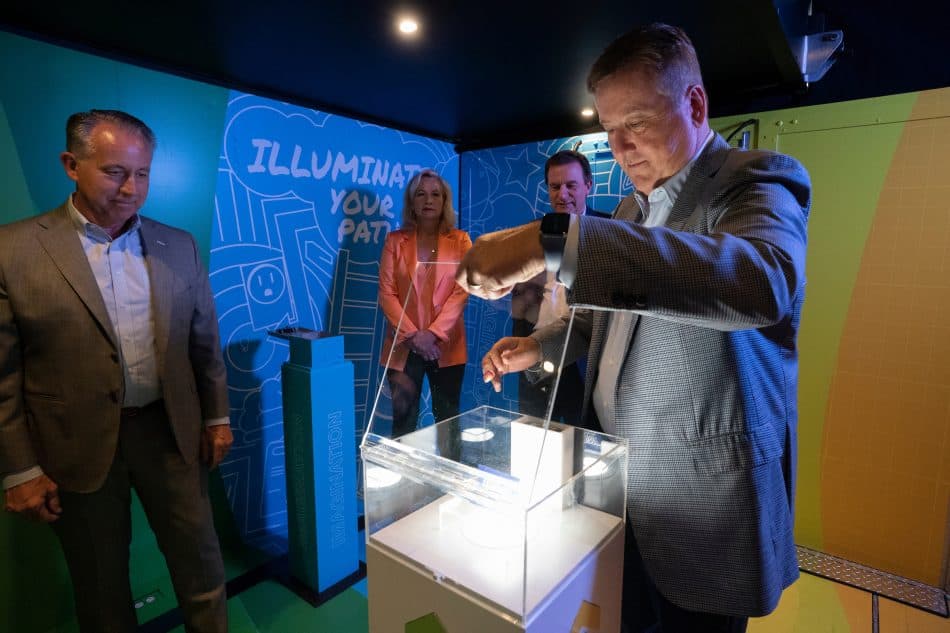
An online choose-your-own-adventure version of the mobile experience will be rolling out this summer to reach students, parental figures, teachers and emerging workers nationwide. Here, MI Executive Director Carolyn Lee previews the “Keys to Success” room, where participants will race to solve riddles that will help reinforce key attributes of manufacturing careers, such as teamwork, problem solving, imagination and communication.
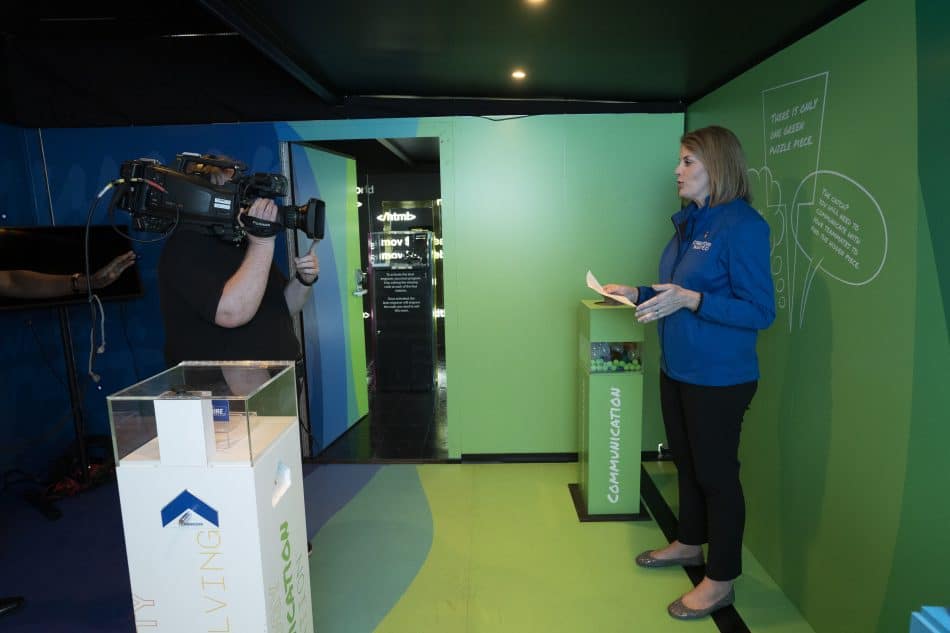
Lee also gave a presentation on Creators Wanted to the visitors. As she said in a statement, “By 2030, manufacturers need to fill more than 4 million jobs—according to research from the MI and Deloitte—but without initiatives like Creators Wanted, more than half of those jobs could go unfilled. This mobile experience will excite audiences across the country, sparking an interest in modern manufacturing so that we can connect emerging and displaced workers with resources that educate and empower.”
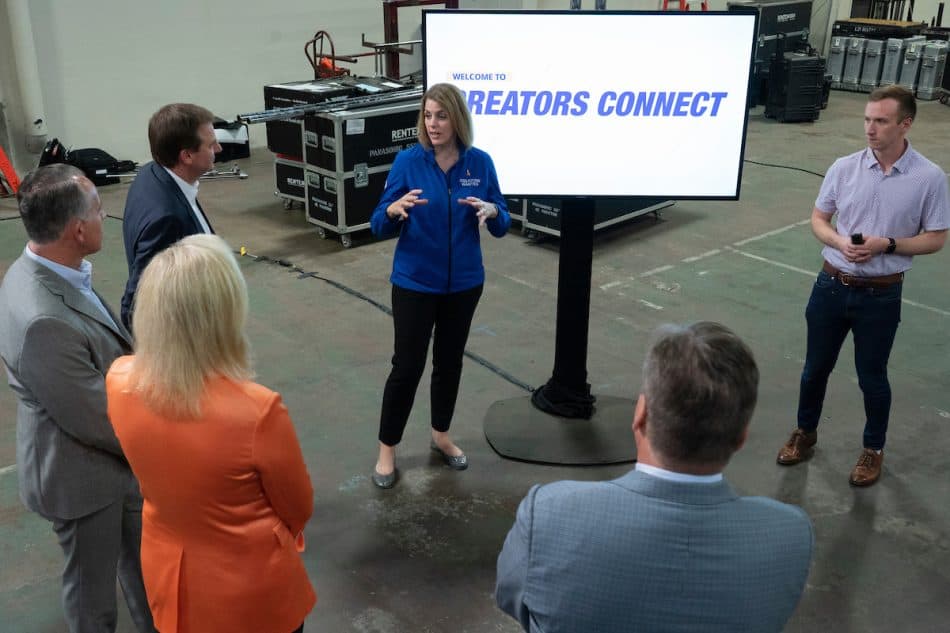
The tour allows you to experience the creativity of manufacturing firsthand and up close. In the gamified experience, participants will work as a team to solve a series of immersive challenges, requiring their full attention to think and compete. As they move through each obstacle, teams will learn more about modern manufacturing careers, the skills required to be successful and how people and technology work together.
We can’t reveal all the surprises, but doesn’t he look excited?
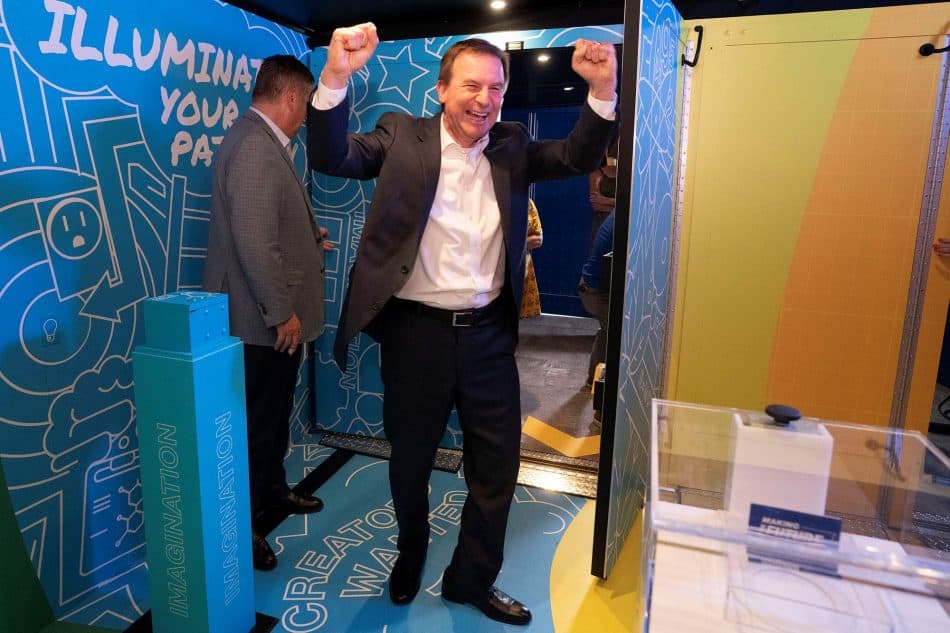
In fact, all of the NAM’s Executive Committee members who toured the exhibition were impressed and amazed by what they saw. Here are some of their reactions:
- “I will admit, I didn’t quite appreciate the opportunity for our industry until I saw the experience in person,” said Chapman. “Seeing is believing in the capacity of this tool to excite the next generation, parents, guardians and teachers about modern manufacturing careers.”
- “It’s clear that Creators Wanted has exactly the message and tools to strengthen our industry’s recruitment for talent. At a time when so many young people seek careers where creativity is valued and prized, we have a chance with this campaign to really drive the best and brightest into our talent pipeline,” said Nielsen.
- “The mobile experience is astounding; it’s unlike anything we’ve done as an industry to reach the next generation and engage emerging and displaced workers. But what makes this campaign worthwhile is that the mobile experience is just one part of a comprehensive plan to create interest and then create opportunity by providing resources to help people launch or grow a career in manufacturing,” said Lamach.
Join in: Last but not least, you too can find out what all the excitement is about. Check out https://creatorswanted.org/ for information about the campaign.
An Army Vet Finds Military Values in Manufacturing

Hugo Hinojosa loved being in the military. He served 22 years in the U.S. Army, with time in eight different duty stations. His service gave him the opportunity to get a degree, travel the world, see different places and forge close-knit friendships that he says will last a lifetime. When it came time for him to transition out of the military, he was open to ideas—and during a career skills program briefing at Fort Hood’s Copeland Center, a presentation from Heroes MAKE America captured his attention.
Endless opportunities: After a career spent moving around the globe, Hinojosa was hoping to stay in his home state of Texas for the long term. During the presentation from a representative of Heroes MAKE America, he was struck by the breadth of roles the manufacturing industry offered.
- “When they came out and told me about opportunities and other jobs in the surrounding area, I said, wow, this might be for me,” said Hinojosa. “With the certifications the program offered, you could work anywhere in the industry. I wasn’t limiting myself to a certain, specific job. I could work anywhere, you name it. The opportunities are endless.”
A unique experience: Hinojosa began his time in the program in the midst of the COVID-19 pandemic, which meant that some elements had to be adjusted to fit the logistical reality. But participants still received plenty of engagement: classroom lessons were shifted to a virtual format, and students met with program managers two at a time for a few hours every week. While it required a fair amount of self-direction and motivation, Hinojosa said that the program supported him as he learned at his own pace.
A powerful network: Hinojosa found the networking aspect of the program to be especially valuable once he began looking for work.
- “Every time we would have potential employers in team meetings, I would search them on LinkedIn and connect with them,” said Hinojosa. “I said, I saw you today during class, I’d like to connect. I started building my own network from there.”
The right stuff: The work paid off. Hinojosa received several offers and ended up getting hired by WestRock Company through meetings that were set up by Heroes MAKE America. He began as a member of the company’s management trainee program and was quickly recruited to work as a business partner in the human resources department. He sees his new career as a natural extension of his time as a service member.
- “Everywhere I go, I’m a steward of the Army,” said Hinojosa. “I’m working in a place where the values are in line with what I was brought up with in the military—integrity, respect, accountability and excellence.”
Today, Hinojosa encourages other transitioning service members to see themselves in a manufacturing career—and most importantly, to recognize their own skills.
The last word: “Don’t sell yourself short,” said Hinojosa. “Believe in the skills the military has given you. You’ve been trained and given skills that will pay dividends out here in the manufacturing industry. And the work ethic that’s instilled from day one is going to show.”
Second Chance Hiring Strengthens Manufacturing
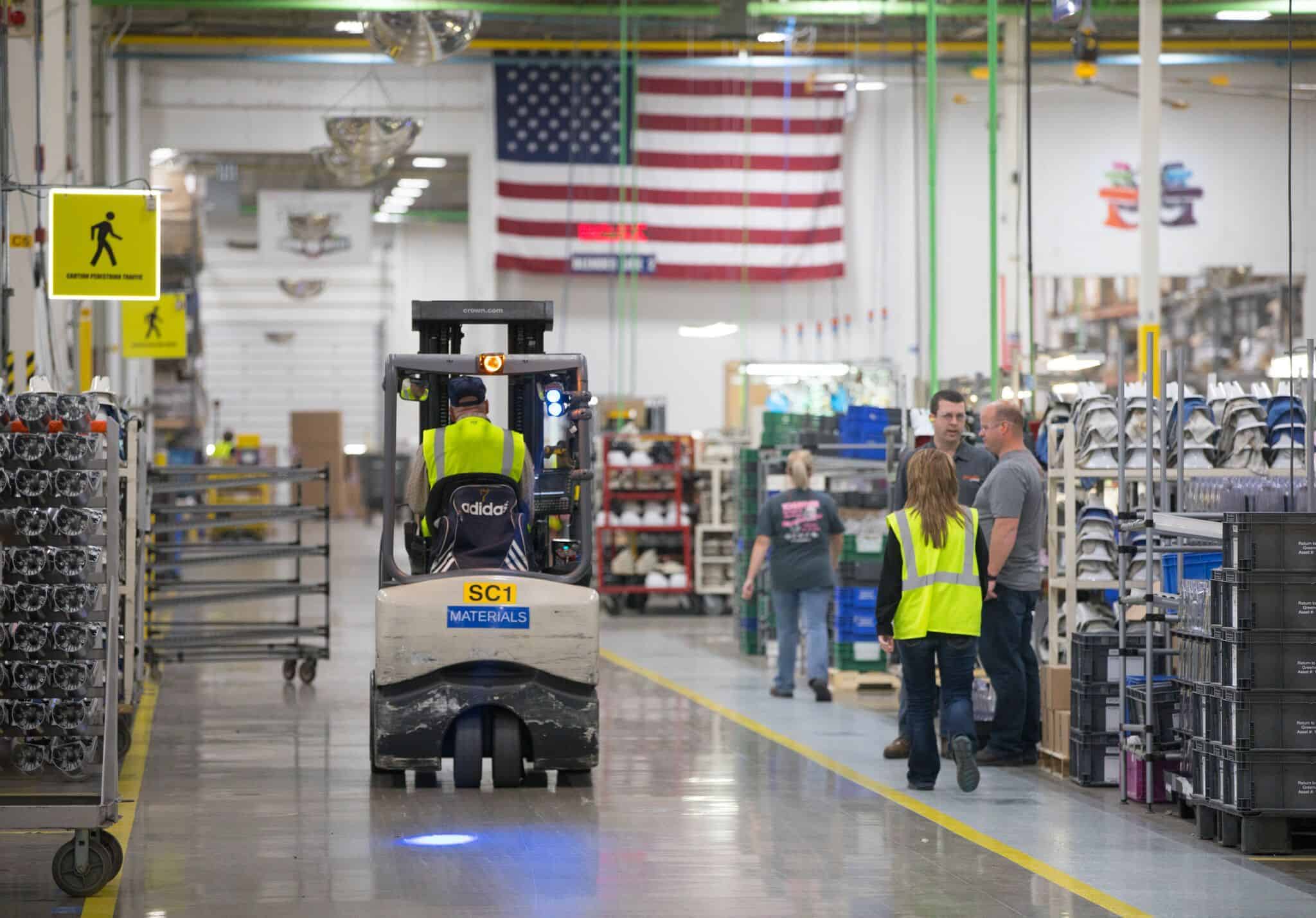
Helping people with criminal records find good jobs is not just the right thing to do, but a way to strengthen the manufacturing industry for years to come. That’s why The Manufacturing Institute—the workforce development and education partner of the NAM—is partnering with Stand Together and the Charles Koch Institute to help manufacturers recruit from this population and fill some of the thousands of job openings within the industry.
Brianna Nuhfer, director of criminal justice for the Stand Together philanthropic community, spoke to us recently about the importance of second chance hiring and the opportunities it offers for manufacturers.
Why it matters: A criminal record is often a significant barrier to employment, preventing people from finding new jobs and building better lives. Not all people with criminal records have been incarcerated, but for those who have been, second chance hiring also significantly increases the success of reentry.
- “The vast majority of incarcerated individuals—over 95% of people who are incarcerated—will be returning to our communities and our neighborhoods,” Nuhfer says. “We want to make sure that their return is as successful as possible, and we know that employment is one of the primary factors that helps people get back on track and avoid recidivism or returning to prison.”
Why it matters for manufacturers: Hiring Americans with criminal records is also important for the success of the manufacturing industry. Right now, manufacturers are facing a significant shortage of skilled workers; in fact, a recent study by Deloitte and the MI suggests that the skills gap could result in 2.1 million unfilled jobs by 2030. Manufacturers need workforce-ready employees, and many people with criminal records fit the bill.
Building a smart workforce: According to Nuhfer, research shows that workers with criminal records often have the lowest turnover rates of all employees. She cites several other key advantages:
- 82% of managers report that the value these workers bring to companies is just as high as—if not higher than—the value that their employees without criminal records provide.
- Many formerly incarcerated people received manufacturing-related training while they were in correctional facilities, preparing them for work in the modern industry.
Building partnerships: The partnership with the MI will increase awareness of second chance hiring opportunities and help manufacturers recruit, train and support these workers.
- “The NAM and The Manufacturing Institute have such an incredible reach across the country, and their leadership is undeniable,” said Nuhfer. “The resources you put out for the field are utilized and noticed—and so your involvement and your commitment to this issue is going to have an incredible ripple effect across the country, opening up thousands of employment opportunities for deserving individuals.”
Creating a culture: For company leaders interested in second chance hiring, Nuhfer has some simple advice: these hiring practices shouldn’t just be a matter of policy, but also a matter of culture. Leaders should demonstrate by example that their companies value smart, talented workers of all backgrounds.
The MI says: “Second chance hiring gives businesses an opportunity to welcome highly motivated, engaged, productive and loyal new team members who may otherwise be overlooked,” said MI Executive Director Carolyn Lee. “This is not only the right thing to do for our businesses, but it’s also the right thing to strengthen our communities.”
The last word: “All of us are more than our choices, good or bad,” said Nuhfer. “None of us wants to be defined by the worst decision we’ve ever made for the rest of our lives.”
To learn more about second chance hiring, register here for an upcoming webinar on June 10.
The Manufacturing Institute Goes to Capitol Hill

Manufacturing Institute Executive Director Carolyn Lee testified virtually before the House Committee on Veterans’ Affairs’ Subcommittee on Economic Opportunity yesterday, detailing the MI’s work with transitioning service members during the pandemic. Here are some highlights from her testimony.
COVID-19’s impact: According to Lee, the COVID-19 pandemic made it much more difficult for transitioning service members to access key resources, including training programs, fellowships and internships.
Our work: The MI’s Heroes MAKE America initiative helped develop workarounds for these challenges, Lee testified.
- “At the onset of the pandemic, we collaborated with our education partners to pivot most of our program delivery to virtual platforms or socially distanced environments—within a matter of weeks,” she said. “COVID-19 also accelerated the deployment of fully remote learning for Heroes participants, proving that we can deliver some certifications online.”
- Lee also highlighted the launch of Heroes Connect, which allowed transitioning service members to network virtually with hiring managers from manufacturers across the country.
Heroes’ overall success: The Heroes program has been very successful since its creation only three years ago, Lee noted. “Since its inception in January 2018, Heroes MAKE America has had a placement rate of 92%. Participants have found jobs at more than 250 companies in 39 states.”
- She added, “Notably, 55% of our participants have no post-secondary education, indicating a strong need for support to position them for success in a career after their time in uniform.”
What policymakers can do: Lastly, Lee recommended policy changes that could make military transitions more accessible to service members and their families.
- First, “Congress should change eligibility requirements for Pell grants to allow students to pursue high-quality programs as short as eight weeks.”
- In addition, Lee recommended a separate allocation of funding under the Workforce Innovation and Opportunity Act for the military community. While those funds are currently given directly to states, which place limits on their use, service members may participate in training virtually or in a different location than where they transition. They need the flexibility to receive training or plan careers without worrying about state lines.
The last word: “Veterans are well positioned to succeed in a manufacturing career with skills, talents and training that are highly valued in the industry,” said Lee. “And with more than 700,000 manufacturing jobs open today—and 4 million to fill by 2030—they are in great demand. The Manufacturing Institute is committed to helping today’s American heroes become tomorrow’s manufacturing leaders.”
MLC Honors Manufacturing Leaders
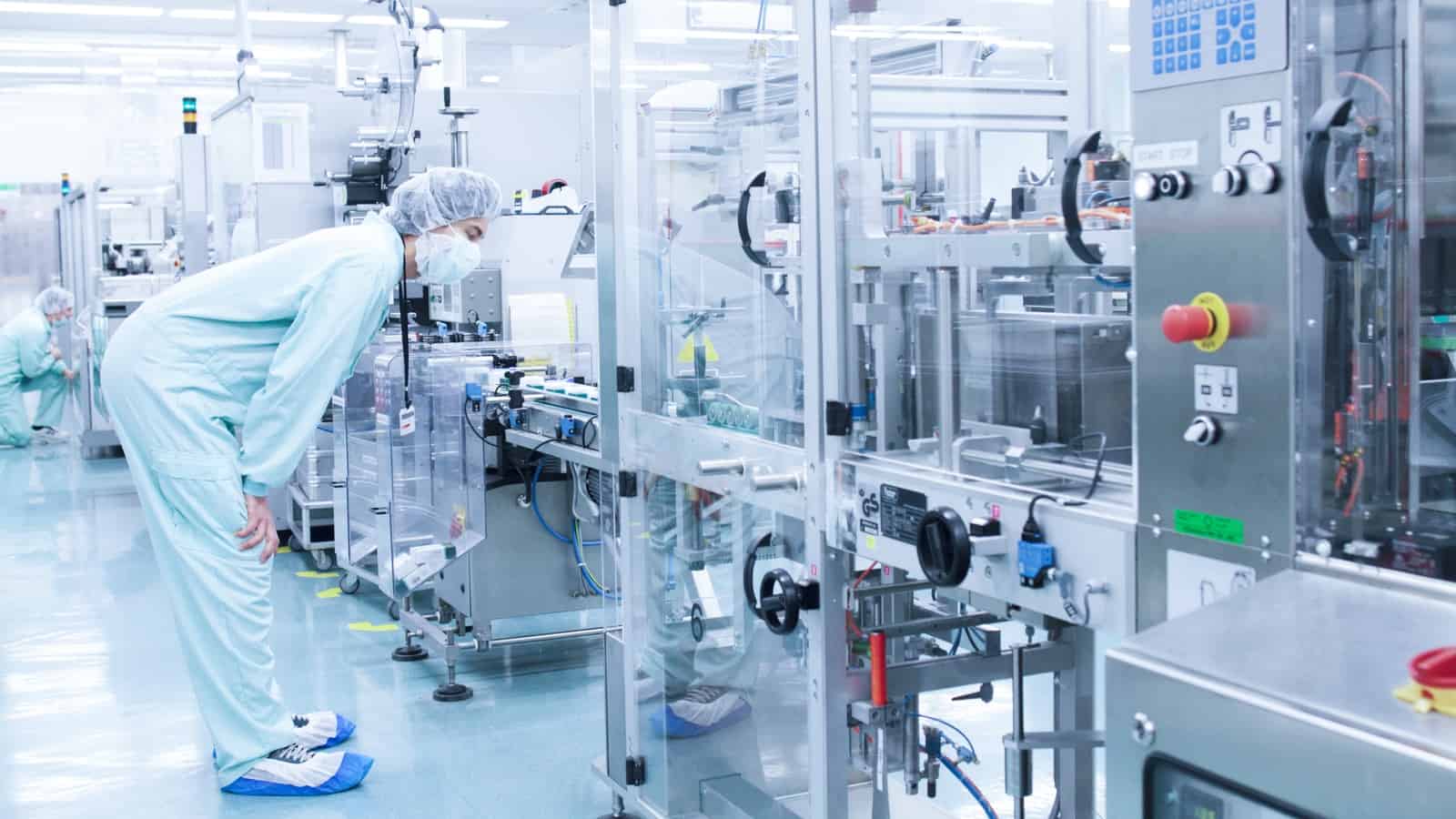
During a year of extraordinary disruptions and challenges, manufacturers stepped up in extraordinary ways. That’s the message of this year’s Manufacturing Leadership Awards, taking place on May 19 and hosted by the NAM’s Manufacturing Leadership Council—a business leadership network dedicated to senior manufacturing executives and aimed at supporting companies through the industry’s digital transformation.
What they are: The Manufacturing Leadership Awards are presented to world-class manufacturing companies and individual leaders in a range of categories, from Artificial Intelligence and Advanced Analytics Leadership to Collaborative Innovation Leadership to Sustainability Leadership. The online gala will recognize exciting and innovative manufacturers who excelled in these areas and will feature a virtual after-party with entertainment for guests.
Among the winners: Here are a few examples of this year’s winning projects.
- A pharmaceutical company partnered with another company to scale up the production of a COVID-19 treatment. As a result of their collaboration, a production transfer that would normally take 12 months was completed in just 123 days.
- An automaker developed a technology center dedicated to making 3D printing a mass-scale production reality for their plants around the world. It is developing new products faster than ever and improving its assembly operations.
- A technology manufacturer implemented AI and edge computing in its inspection process, reducing inspection times from 10 minutes to less than one minute while significantly improving inspection accuracy.
New and of note: One new element of this year’s celebration is the Creators Respond Honor Roll. So many manufacturers went above and beyond in responding to the global pandemic that the MLC decided to recognize their achievements in a separate category.
Still to come: Several honorees won’t be announced publicly until the gala itself, including the High Achievers, Manufacturers of the Year and Manufacturing Leaders of the Year—so be sure to tune in on May 19.
The word from the MLC: “Tested with challenges they never could have imagined, manufacturers rose to the occasion to keep factories open, sometimes with significant changes to their production and supply chains,” said Manufacturing Leadership Council Co-Founder, Executive Director and Vice President David R. Brousell. “At the same time, manufacturers doubled down on digital transformation as they sought greater agility and flexibility in their businesses. These awards honor the innovation and resolve that manufacturers demonstrate at all times, and especially in times of crisis.”
You can RSVP for the event here.
2.1 Million Manufacturing Jobs Could Go Unfilled by 2030
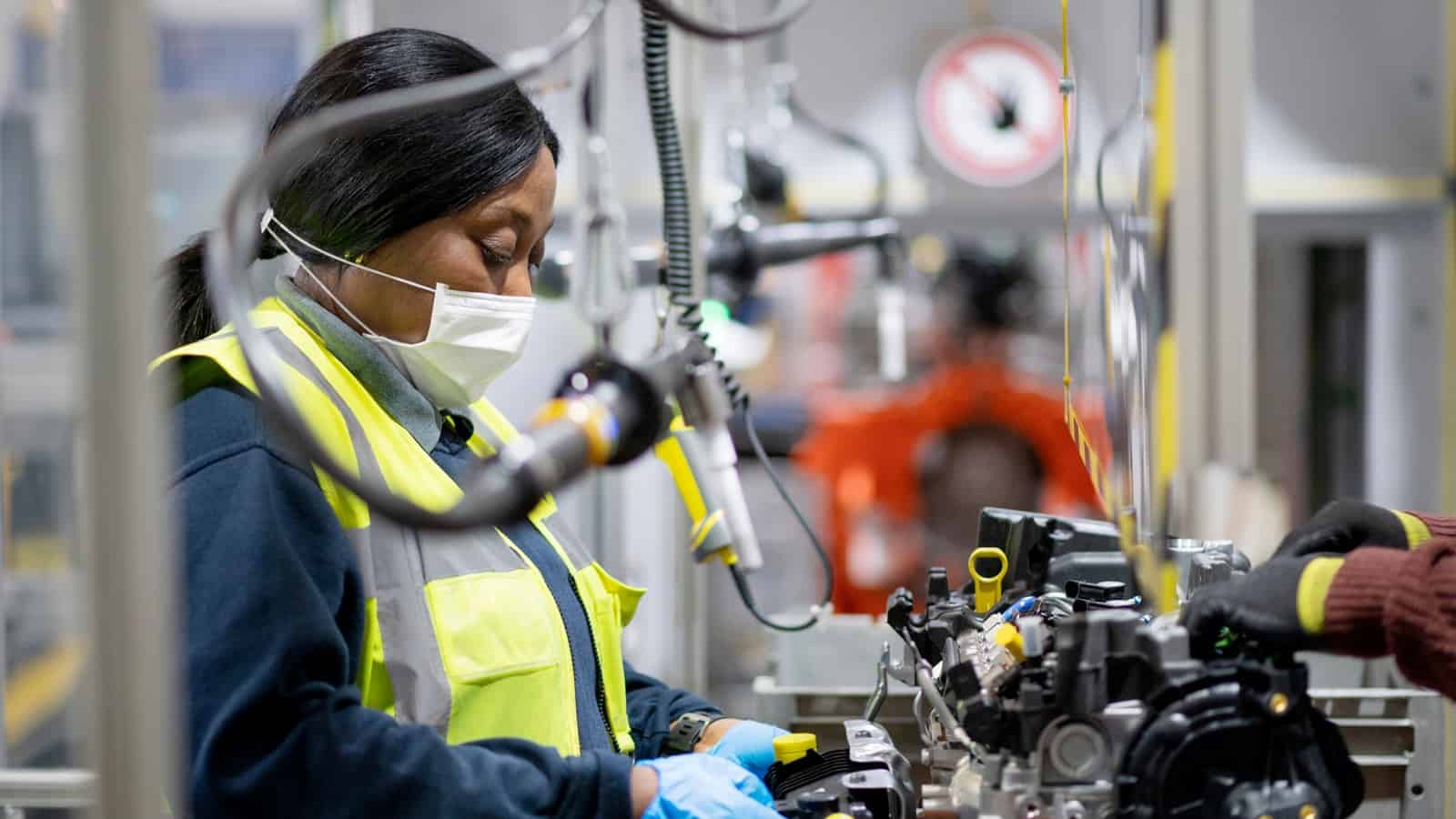
The manufacturing skills gap in the U.S. could result in 2.1 million unfilled jobs by 2030, according to a new study by Deloitte and The Manufacturing Institute, the workforce development and education partner of the NAM. The cost of those missing jobs could potentially total $1 trillion in 2030 alone.
The study’s dramatic findings come from online surveys of more than 800 U.S.-based manufacturing leaders, as well as interviews with executives across the industry and economic analyses. All told, they paint a worrying picture of manufacturing’s labor shortage. The lack of skilled labor was the industry’s major challenge even before the pandemic, according to the NAM’s quarterly outlook surveys—and this new study shows it’s still a major concern today.
The hard data: About 1.4 million U.S. manufacturing jobs were lost during the early days of the pandemic, according to the study, setting back the manufacturing labor force by more than a decade. However, the industry has largely recovered those lost jobs and is now urgently seeking more workers.
- While the manufacturing industry recouped 63% of jobs lost during the pandemic, the remaining 570,000 had not been added back by the end of 2020, despite a near record number of job openings in the sector.
The inside scoop: Manufacturers surveyed reported that finding the right talent is now 36% harder than it was in 2018, even though the unemployment rate has nearly doubled the supply of available workers.
- Executives reported they cannot even fill higher paying entry-level production positions, let alone find and retain skilled workers for specialized roles.
- A long-term challenge: 77% of manufacturers say they will have ongoing difficulties in attracting and retaining workers in 2021 and beyond.
A bright spot: Fortunately, the study found that diversity, equity and inclusion (DEI) initiatives exert a growing influence on workforce trends and can help manufacturers fill these empty jobs. Manufacturers have more work to do to attract larger numbers of women and diverse workers to the industry, and the Institute is leading an industry-wide effort to close the opportunity gap.
Deloitte says: “Given the foundational role the manufacturing sector plays in our nation’s economy, it is deeply concerning that at a time when jobs are in such high demand nationwide, the number of vacant entry-level manufacturing positions continues to grow,” said Paul Wellener, Deloitte vice chairman and U.S. industrial products and construction leader. “Attracting and retaining diverse talent presents both a challenge and solution to bridging the talent gap. To attract a new generation of workers, the industry should work together to change the perception of work in manufacturing and expand and diversify its talent pipeline.”
The Institute says: “Manufacturers are proud to lead efforts to build stronger, more diverse and inclusive workplaces because we are committed to being the solution,” said Carolyn Lee, executive director of the Institute. “As we expand our programs at The Manufacturing Institute, and work with the National Association of Manufacturers on initiatives like our Creators Wanted campaign and tour, we’re making sure that Americans of all backgrounds in all states can find a home in manufacturing and get equipped with the skills to seize these opportunities.”
Manufacturing Institute Takes on Second Chance Hiring
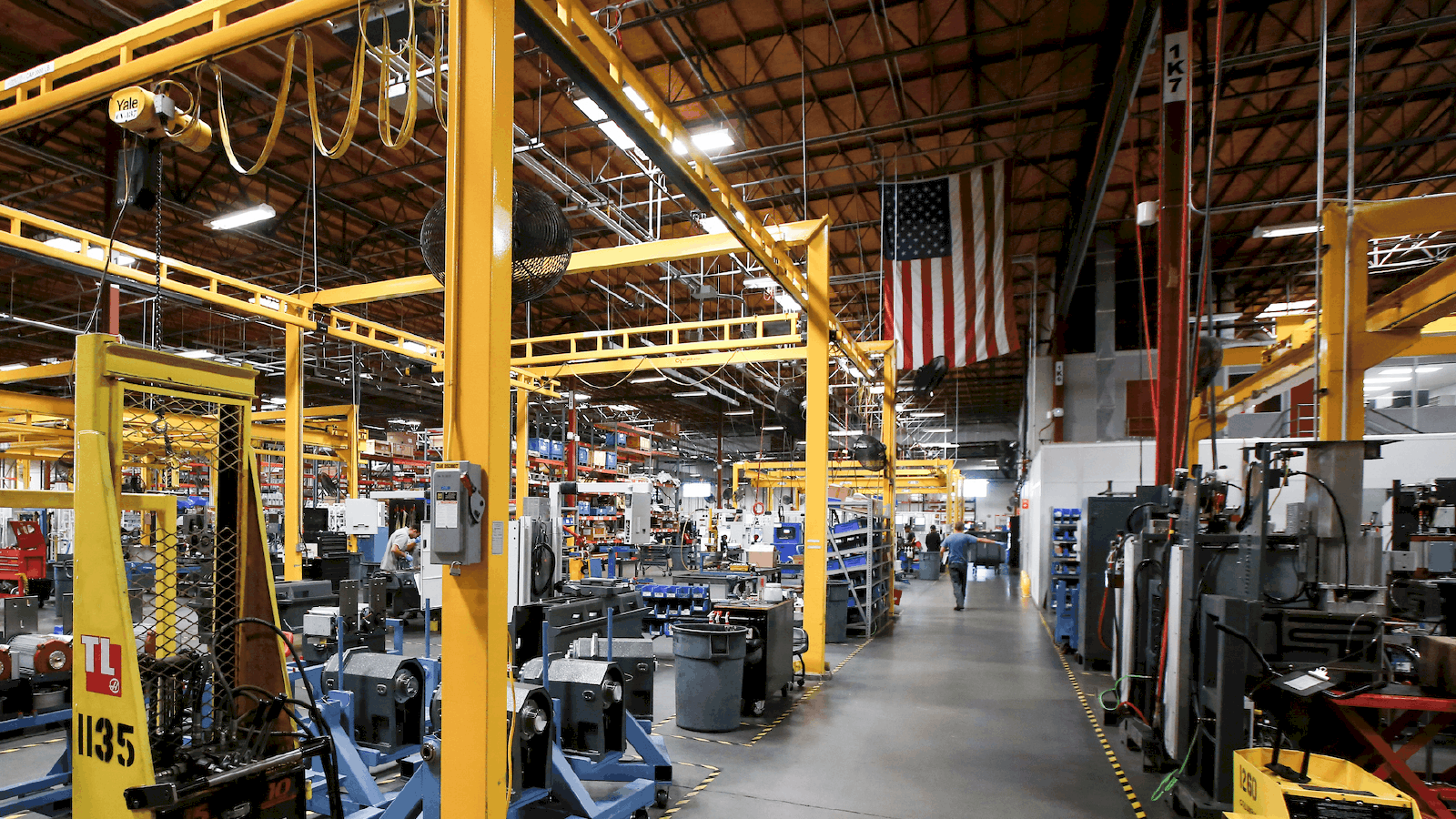
The Manufacturing Institute—the workforce development and education partner of the NAM—is partnering with the Charles Koch Institute to expand second chance hiring opportunities in the manufacturing industry.
What is second chance hiring? One in three Americans possess a criminal record. Without being offered a “second chance” at a stable job, many in this sizable talent pool are excluded from the workforce.
Why it matters: The manufacturing industry has more than half a million jobs open right now and will need to fill 4 million over the next decade. Second chance programs not only increase equal opportunity and diversity in the industry but are also a key tool for building manufacturing’s future workforce.
What we’re doing about it: The MI’s initiative, funded by a grant from the Charles Koch Institute, will offer resources and expertise to help employers make the best use of second chance hiring. These resources will include roundtable discussions and webinars, C-suite leadership events, case studies, a pilot program and original research for the manufacturing industry.
The MI says: “Second chance hiring gives businesses an opportunity to welcome highly motivated, engaged, productive and loyal new team members that may otherwise be overlooked,” said MI Executive Director Carolyn Lee. “This is not only the right thing to do for our businesses, but it’s also the right thing to strengthen our communities.”
- “This partnership enables the MI to educate manufacturers in America on second chance hiring best practices and help them utilize second chance hiring as a strategy to fill open jobs. This effort will also expand our Diversity and Inclusion initiative that’s critical to the future health and success of the industry.”
A real-world example: Nehemiah Manufacturing Co., a consumer-product manufacturer in Cincinnati, has a workforce of about 180 employees—about 80% of whom have criminal records, according to The Wall Street Journal (subscription). These employees serve in all sorts of positions, including leadership roles, from production to fulfillment and more.
- “We found that the population we were hiring who had criminal backgrounds were our most loyal people,” Nehemiah President Richard Palmer told the Journal. “When we were looking for people to work overtime, come in on Saturday or go that extra mile, it was the second-chance population that was saying, ‘I’m in.’”
The last word: “One of the biggest barriers to successful reentry for those with a record is lack of employment opportunities,” said CKI Executive Director Derek Johnson. “If we truly want to reduce recidivism and increase public safety, all while empowering those returning to our communities to contribute at their fullest potential, we need to expand second chance hiring opportunities. CKI is proud to join this partnership to scale that impact and expand second chance hiring across more employers.”
Consequences of a Higher Corporate Tax Rate: 1 Million Jobs Lost in First Two Years
Timmons: “America can’t afford that, especially now.”
Washington, D.C. – The National Association of Manufacturers released a new study detailing the short- and long-term damage to the American economy under tax proposals to increase the corporate tax rate and repeal policies that made manufacturing in America more competitive around the world.
“Manufacturers want to help President Biden achieve his goal of creating jobs in America and strengthening the supply chain so that our country does not face critical shortages, especially during times of national crises.
“As we slowly emerge from the economic catastrophe caused by COVID-19, American businesses are at a pivotal point in our nation’s history. Manufacturers can, and should, lead the economic recovery in the wake of the pandemic. But this study tells us quantitatively what manufacturers from coast to coast will tell you qualitatively: increasing the tax burden on companies in America means fewer American jobs. One million jobs would be lost in the first two years, to be exact,” said NAM President and CEO Jay Timmons.
“After decades of advocating for a tax system that provided competitive rates and modern international tax provisions, manufacturers in America kept our promises following the enactment of the 2017 tax reforms: we raised wages and benefits, we hired more American workers, and we invested in our communities. If we undo those reforms, all of that will be put at significant risk. Manufacturing workers will lose out on jobs, growth and raises. We should be building on that progress, not rolling it back. But the conclusion of this study is inescapable—follow through with tax hikes that give other countries a clear advantage and we’ll see far fewer jobs created in America.”
The study calculated the effects of increasing the corporate tax rate to 28%, increasing the top marginal tax rate, repealing the 20% pass-through deduction, eliminating certain expensing provisions and more. The negative consequences would include the following:
- One million jobs lost in the first two years;
- By 2023, GDP would be down by $117 billion, by $190 billion in 2026 and by $119 billion in 2031;
- Ordinary capital, or investments in equipment and structures, would be $80 billion less in 2023 and $83 billion and $66 billion less in 2026 and 2031, respectively;
- And more.
“There are some who are well-meaning and have suggested that the U.S. corporate tax rate should increase, but not by as much as the 28% proposed. Unfortunately, what that means is that America will still lose jobs and investment, just not quite as much. America just can’t afford that, especially now,” Timmons said.
Click here for a summary of the study’s details and findings. Read the full study, “Dynamic Estimates of the Macroeconomic Effects of Tax Rate Increases and Other Tax Policy Changes,” conducted by Rice University economists John W. Diamond and George R. Zodrow,” here
Background on manufacturing growth following the enactment of tax reform in 2017:
- In 2018, manufacturers added 263,000 new jobs. That was the best year for job creation in manufacturing in 21 years.
- In 2018, manufacturing wages increased 3% and continued going up—by 2.8% in 2019 and by 3% in 2020. Those were the fastest rates of annual growth since 2003.
- Manufacturing capital spending grew by 4.5% and 5.7% in 2018 and 2019, respectively.
- Overall, manufacturing production grew 2.7% in 2018, with December 2018 being the best month for manufacturing output since May 2008.
Manufacturers strongly support President Biden’s focus on bold infrastructure investment, which can be achieved through a combination of revenue sources like those identified in the NAM’s ‘Building to Win.’
-NAM-
The National Association of Manufacturers is the largest manufacturing association in the United States, representing small and large manufacturers in every industrial sector and in all 50 states. Manufacturing employs more than 12.3 million men and women, contributes $2.32 trillion to the U.S. economy annually and has the largest economic multiplier of any major sector and accounts for 63% of private-sector research and development. The NAM is the powerful voice of the manufacturing community and the leading advocate for a policy agenda that helps manufacturers compete in the global economy and create jobs across the United States. For more information about the NAM or to follow us on Twitter and Facebook, please visit www.nam.org
Manufacturers: Build Now for the Post-Pandemic World
When manufacturing is strong, America is strong
Washington, D.C. – National Association of Manufacturers President and CEO Jay Timmons released the following statement on President Joe Biden’s infrastructure framework.
“The President’s proposal for historic levels of infrastructure investment reflects many of the investment priorities in the NAM’s ‘Building to Win’ plan, and we look forward to reviewing the details. President Biden’s clear focus on strengthening manufacturing and the workforce of the future shows that he is truly committed to building the next post-pandemic world—one that is stronger and more resilient than in pre-pandemic times.
“Manufacturers have played a leading role in the fight against COVID-19, and we will continue to play a leading role in our economic recovery. When manufacturing is strong, America is strong.
“One thing is clear for our industry, though. Raising taxes on manufacturers would fundamentally undermine our ability to lead this recovery. Our industry fought for decades to achieve a tax system that includes competitive rates and modern international tax provisions. As a result of the 2017 reforms, manufacturers kept our promises: we raised wages and benefits, we hired American workers, and we invested in our communities. Raising taxes on manufacturers here at home would jeopardize all of that and make it more difficult for them to compete in the global economy—putting investment, jobs and livelihoods at risk. We believe strongly in bold infrastructure investment, and we know it can be achieved through a combination of revenue sources like those we identified in the NAM’s ‘Building to Win,’ which includes user fees and bond financing for capital projects. We also know that making the men and women who make things in America pay for the infrastructure projects that will benefit all Americans just doesn’t make sense and would harm their future. Let’s keep moving forward and not turn back the clock to the archaic tax policies that gave other countries an advantage over America.
“To be sure, President Biden’s proposal on infrastructure investment is strong, necessary and welcome. Achieving our shared goals will be the result of debate, discussion and collaboration with the administration and both parties in Congress. We can achieve the President’s investment objectives while holding firm against financing proposals that would severely harm the ability of manufacturers to invest and hire workers here in the U.S. We look forward to engaging with all stakeholders to achieve an outcome that benefits all economic sectors and all Americans.”
Background on manufacturing growth following the enactment of tax reform in 2017:
- In 2018, manufacturers added 263,000 new jobs. That was the best year for job creation in manufacturing in 21 years.
- In 2018, manufacturing wages increased 3% and continued going up—by 2.8% in 2019 and by 3% in 2020. Those were the fastest rates of annual growth since 2003.
- Manufacturing capital spending grew by 4.5% and 5.7% in 2018 and 2019, respectively.
- Overall, manufacturing production grew 2.7% in 2018, with December 2018 being the best month for manufacturing output since May 2008.
-NAM-
The National Association of Manufacturers is the largest manufacturing association in the United States, representing small and large manufacturers in every industrial sector and in all 50 states. Manufacturing employs more than 12.3 million men and women, contributes $2.32 trillion to the U.S. economy annually and has the largest economic multiplier of any major sector and accounts for 63% of private-sector research and development. The NAM is the powerful voice of the manufacturing community and the leading advocate for a policy agenda that helps manufacturers compete in the global economy and create jobs across the United States. For more information about the NAM or to follow us on Twitter and Facebook, please visit www.nam.org.
Why a Navy Machinist Chose a Manufacturing Career
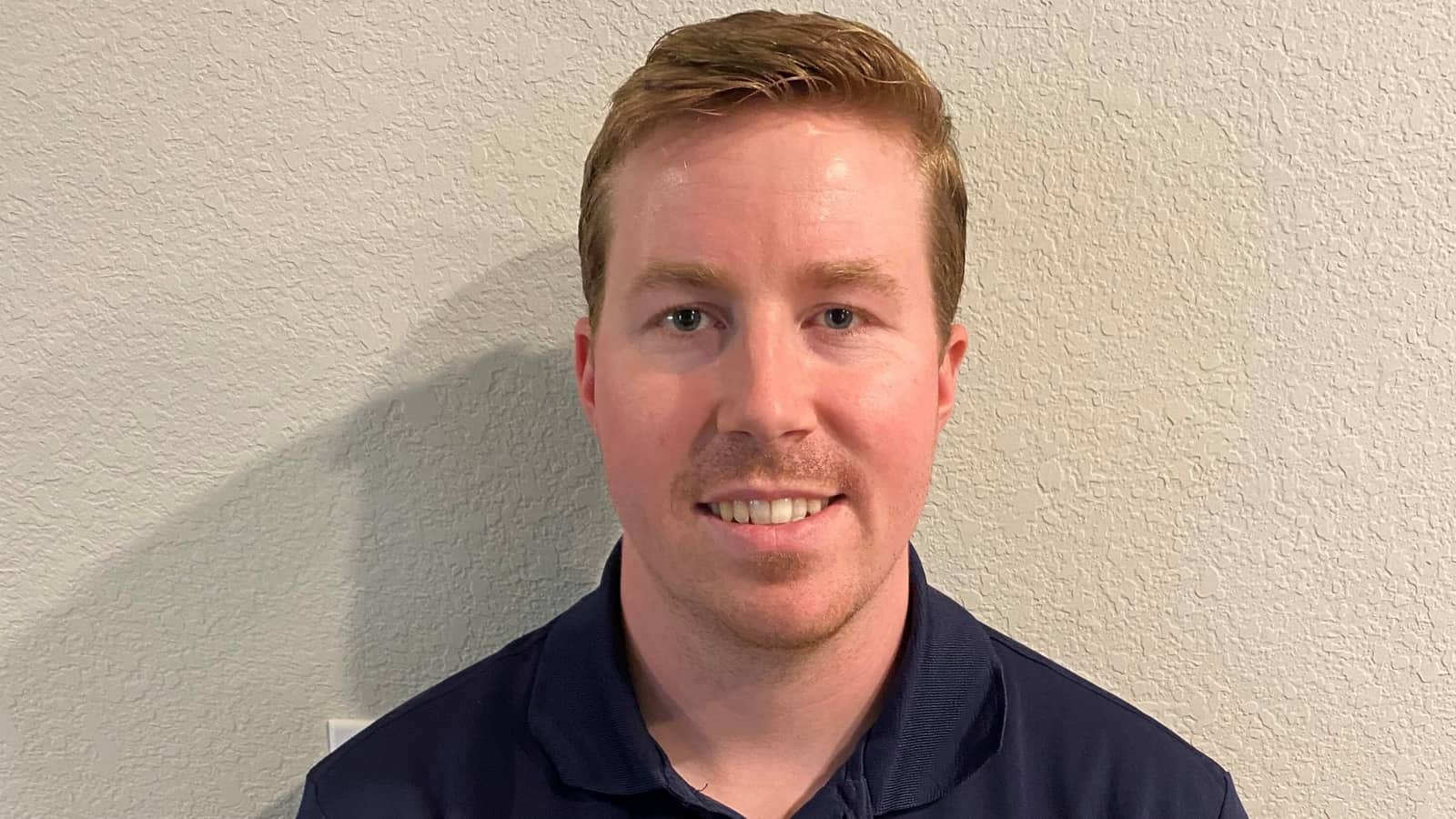
Derek Read always knew he wanted to join the Navy, and he enlisted after high school—rising to become a machinist’s mate responsible for maintaining, repairing and running the ship’s engine as well as corresponding machines and equipment. However, when it came time to find his next career nine years later, he wasn’t sure what to do—until his research turned up the The Manufacturing Institute’s Heroes MAKE America program, which helped Read translate the skills he already had into a modern manufacturing setting.
- “It’s definitely been enlightening,” said Read. “For the most part, I had the mechanical background and most of the skills, but HMA bridged the gap and gave me some technical expertise, as well as the extensive knowledge and certifications needed to get hired by a manufacturing company. Overall, it’s been an amazingly positive experience.”
One-on-one: Some of Read’s most valuable experiences were his meetings with executives and hiring officers at different manufacturing companies.
- “One of the greatest things they’ve given us is facetime with manufacturing company VPs, HR representatives and recruiters,” said Read. “They allowed us to get a better understanding of what was out there and what companies were looking for. Facetime like that is hard to come by unless you’re doing a specialized program like this, and it’s worth a lot.”
What’s next: Today, Read is fielding a few different job interviews, which he received via LinkedIn after Heroes helped him create his profile on the site. “Without HMA, I probably wouldn’t have been approached by those companies,” said Read.
Paying it forward: When asked what advice he’d give to other transitioning servicemembers considering the Heroes program, Read didn’t hesitate. “That’s easy—you’d be crazy not to take advantage of an amazing opportunity like this,” said Read. “The HMA program is outstanding. Take advantage of programs like this one, and don’t wait. Different manufacturing companies have a vast array of jobs. There’s definitely a job out there for you.”
From a distance: What makes Read’s enthusiasm all the more compelling is that he experienced the entire program remotely. But with the help of some virtual reality tools, he was able to participate without missing a step.
- “The VR goggles—that was amazing,” said Read. “I’ve never played with VR before. It’s almost like a video game. The training and tool seminars—I got to play with different tools and interact with the VR, doing measurements, calibrating equipment and going over parts of the manufacturing facility. It was a lot of fun to play with.”
That kind of substantive learning in an engaging environment is what the Caterpillar Foundation will bring to more heroes in the coming years, thanks to its new $2.25 million donation designed to help Heroes MAKE America increase its integration of virtual reality technology and expand training opportunities for the military community.
The last word: As Caterpillar Chairman and CEO Jim Umpleby said when the partnership was announced, “Caterpillar is proud of the support provided to veterans and their families through the Caterpillar Foundation’s donation to the Heroes MAKE America program. I am pleased the Foundation can help make this world-class skills training program available to all members of the global military community and connect them to careers in manufacturing.”
